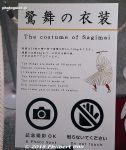Central Tsuwano 津和野の散歩
|
Title   • File Name • File Name   • Date • Date   • Position • Position   |
|

I really liked Tsuwano. It's a small town surrounded by steep mountains. It feels like a Swiss resort in the Alps. It has traditional buildings and the famous Inari Shrine. Photogenic place.Tsuwano is also a National Important Traditional Townscape Preservation District (重要伝統的建造物群保存地区).
JR Tsuwano Station
|
|

In front of JR Tsuwano Station is the Shisei Kuwabara Photographics Museum that exhibits photos by documentary photographer Shisei Kuwabara who is from Tsuwano.
|
|

Entrance to the photo museum in Tsuwano. The museum also houses the local tourist information office. 桑原史成写真美術館
|
|

Inside Shisei Kuwabara Photographics Museum. The museum was originally a documentary photo museum and they asked Kuwabara if they could rename it in 2004. So it exhibits mainly his photos, although it does not preserve or possess his photos. So it's
|
|

Inside Shisei Kuwabara Photographics Museum. It's a nice museum, but only one exhibition room, not huge, but it's large enough.
|
|

Shisei Kuwabara (b. 1936) is still alive and is originally from Tsuwano. He's a documentary photographer most famous for his Minamata disease photos (like W. Eugene Smith).
|
|

Right across the street from the photo museum is another art museum dedicated to another local artist (illustrator) named Mitsumasa Anno.Anno Art Museum (opened in 2001), shows artworks by Mitsumasa Anno who was born and raised in Tsuwano. 安野光雅美術館
|
|

Entrance to Anno Art Museum during New Year's.
|
|

Lobby of Anno Art Museum.
|
|

First floor is the main exhibition space of Anno Art Museum. 安野光雅美術館
|
|

Other parts of Anno Art Museum include an old-style classroom (from 1920s design) and planetarium.
|
|
|
|
|
|

Library at Anno Art Museum.
|
|

Entrance to Tono-machi road lined with traditional buildings. 殿町通り
|
|

Even the Tsuwano Post Office looks fancy.
|
|

Tono-machi road in early morning.
|
|

Tsuwano's Japan Heritage Center is a small local museum.
|
|

Inside Tsuwano's Japan Heritage Center.
|
|

Second floor of Tsuwano's Japan Heritage Center explained the local Sagimai White Heron Dance.
|
|

About Sagimai White Heron Dance costumes.
|
|

White Heron is a symbol of Tsuwano.
|
|
|
|
|

More traditional Japanese buildings on Tono-machi road.
|
|
|

Tsuwano manhole
|
|
|
|
|
|
|
|
|
|
|
|
|
|

Red roof tiles are common in the San'in Region.
|
|
|
|
|
|

Tono-machi road
|
|
|

Another sight along Tono-machi road is the Tsuwano Catholic Church. 津和野カトリック教会
|
|

Tsuwano Catholic Church dedicated to Saint Francis Xavier who visited Japan as a Christian missionary in 1549–50. 津和野カトリック教会
|
|

Stained glass inside Tsuwano Catholic Church. 津和野カトリック教会
|
|

Inside Tsuwano Catholic Church. 津和野カトリック教会
|
|

Inside Tsuwano Catholic Church. 津和野カトリック教会
|
|
|
|
|
|

The famous koi carp in the roadside stream along Tono-machi road.
|
|
|
|
|
|
|
|
|

This traditional builing was being renovated.
|
|
|
|

Sagimai statue
|
|

Sagimai statue in Tsuwano, Shimane.
|
|
|
|

Beautiful restrooms in Tsuwano.
|
|
|
|

End of Tonomachi road.
|
|

This torii leads to Taikodani Inari shrine, Tsuwano's main attraction. (See the separate album).
|
|
|

Walked along the river...
|
|
|

Tsuwano Castle ruins on this mountain.
|
|

Tsuwano Castle ruins in Shimane.
|
|

Taikodani Inari shrine can be seen.
|
|
|

Tsuwano has signs in English.
|
|

Mori Ogai's birth home. 森鴎外旧宅
|
|
|
|

Mori Ogai's birth home. 森鴎外旧宅
|
|

Mori Ogai's birth home. 森鴎外旧宅
|
|

Mori Ogai's birth home. 森鴎外旧宅
|
|

Kitchen of Mori Ogai's birth home. 森鴎外旧宅
|
|
|
|
|
|
|
|
|

Statue of Mori Ogai at his birth home. 森鴎外旧宅
|
|

Statue of Mori Ogai at his birth home. 森鴎外旧宅
|
|
|

Mori Ogai Memorial Museum 森鴎外記念館
|
|
|
|
|
|
|